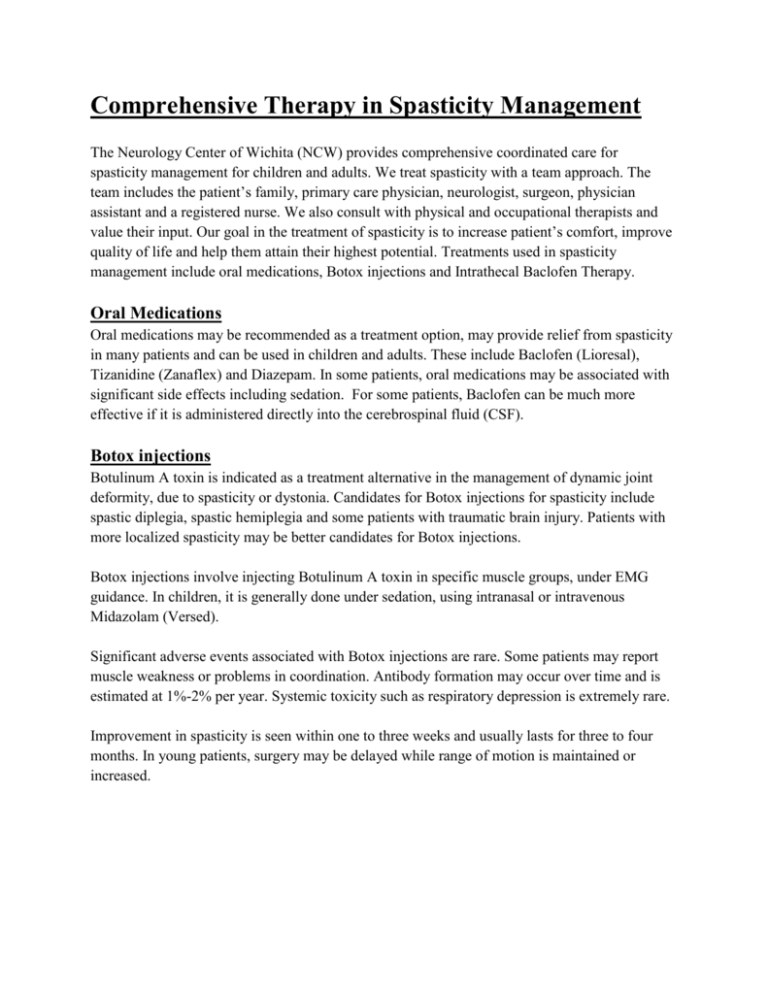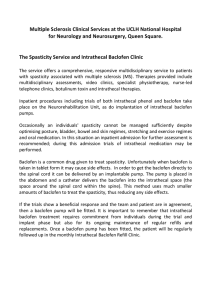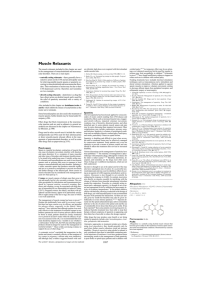Comprehensive Therapy in Spasticity Management
advertisement

Comprehensive Therapy in Spasticity Management The Neurology Center of Wichita (NCW) provides comprehensive coordinated care for spasticity management for children and adults. We treat spasticity with a team approach. The team includes the patient’s family, primary care physician, neurologist, surgeon, physician assistant and a registered nurse. We also consult with physical and occupational therapists and value their input. Our goal in the treatment of spasticity is to increase patient’s comfort, improve quality of life and help them attain their highest potential. Treatments used in spasticity management include oral medications, Botox injections and Intrathecal Baclofen Therapy. Oral Medications Oral medications may be recommended as a treatment option, may provide relief from spasticity in many patients and can be used in children and adults. These include Baclofen (Lioresal), Tizanidine (Zanaflex) and Diazepam. In some patients, oral medications may be associated with significant side effects including sedation. For some patients, Baclofen can be much more effective if it is administered directly into the cerebrospinal fluid (CSF). Botox injections Botulinum A toxin is indicated as a treatment alternative in the management of dynamic joint deformity, due to spasticity or dystonia. Candidates for Botox injections for spasticity include spastic diplegia, spastic hemiplegia and some patients with traumatic brain injury. Patients with more localized spasticity may be better candidates for Botox injections. Botox injections involve injecting Botulinum A toxin in specific muscle groups, under EMG guidance. In children, it is generally done under sedation, using intranasal or intravenous Midazolam (Versed). Significant adverse events associated with Botox injections are rare. Some patients may report muscle weakness or problems in coordination. Antibody formation may occur over time and is estimated at 1%-2% per year. Systemic toxicity such as respiratory depression is extremely rare. Improvement in spasticity is seen within one to three weeks and usually lasts for three to four months. In young patients, surgery may be delayed while range of motion is maintained or increased. Intrathecal Baclofen Therapy ITB has been approved for treatment of spasticity of spinal and cerebral origin. Patients with spinal cord trauma, degenerative spinal disease, cerebral palsy, traumatic brain injury or multiple sclerosis may benefit from ITB therapy. In addition, patients who have had a stroke and have intractable spasticity may also benefit from ITB therapy. The main advantage of ITB therapy is that spasticity can be improved without much systemic side effects. Administration of Baclofen directly into the intrathecal space allows effective cerebrospinal fluid (CSF) concentrations to be achieved, with resulting plasma concentrations 100 times less than those occurring with oral medication. The dose of intrathecal baclofen may be titrated to obtain maximum benefit. Each patient has his/her own dosing requirement. Simple continuous infusion cycle provides a constant hourly rate throughout the day. Complex continuous infusion cycle provides relief of symptoms at certain times of the day more than others. ITB can be programmed at a higher rate to relieve painful spasms when they occur or during the period of physical therapy. Finally, periodic boluses may be given to give additional relief during specific hours of the day. The goals of ITB therapy are significant relief from spasticity, increased patient comfort, ease of daily care, improved quality of life, prevention of complications due to spasticity such as contractures, scoliosis or hip dislocations and in some patients, improved ambulation. Complications associated with ITB therapy include usual complications of surgery and anesthesia including wound infection, poor wound healing, etc., infection of the implanted device, meningitis, obstruction or tear of the catheter, seroma and CSF leakage. Rarely, Baclofen overdose can occur which is reversible. In our experience at NCW, cumulative incidence of these complications is less than 5%. Implantation of a Baclofen pump occurs in several steps. First the team of a primary care physician, neurologist, physical and occupational therapists need to identify patients who could benefit from ITB therapy. Then a trial dose of intrathecal baclofen is given via lumbar puncture. A physical therapist evaluates the patient before and after the ITB injection to determine the extent of improvement in spasticity. If significant improvement (greater than 1 point decrease in the Ashworth spasticity score) is seen, the surgeon implants a pump (10ml or 18ml size) and a spinal catheter. The tip of the catheter is usually placed at mid to low thoracic region. The higher the catheter is placed, the more improvement is seen in the upper extremities. Patients are more sensitive to changes in Baclofen rate when the catheter is placed high. Total hospitalization of the ITB trail and surgery is 3-5 days. Follow up care includes refill of the pump every one to three months. The Baclofen dose can be adjusted using a computer programmer in a completely non-invasive manner. Mission Statement: At NCW, our mission is to help children and adults realize their highest potential, greatest independence and well being.











